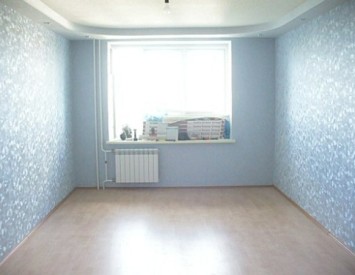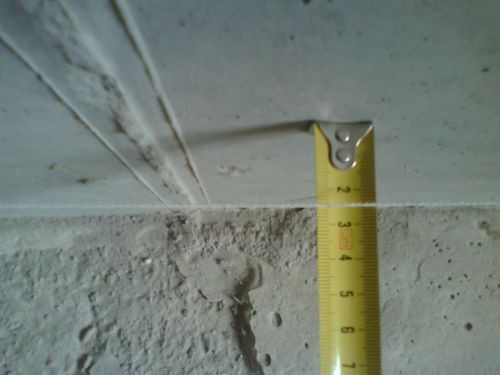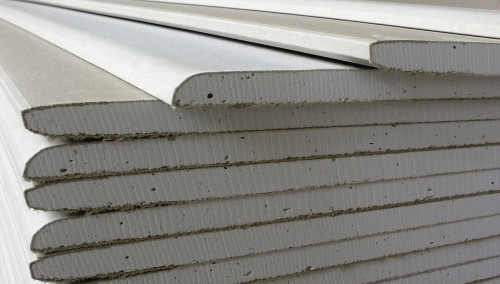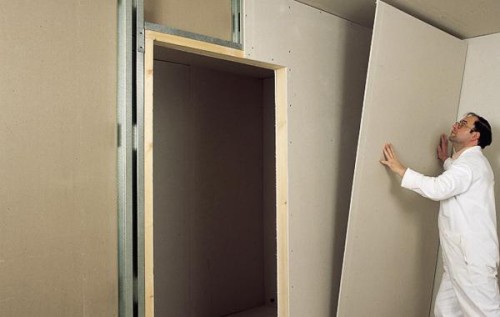There are many ways of finishing walls, but most of them require an even and direct foundation, but in reality everything is not so smooth. The walls of modern houses, and even more so the old buildings, only seem even, but are not suitable for cladding with tiles, laminate or panels, since they have horizontal or vertical changes invisible to the eye. In this article, we will tell you how to correctly level the walls under the finishing of any materials.
Content
Preparatory work
Any repair begins with preparation, and the leveling of the walls is no exception. In this case, first of all, it is necessary to determine the degree of irregularity of the surface in order to know the better to align the walls and how many materials are needed.
How to determine the degree of curvature of the wall:
- Arm with a long construction rule of 2-2.5 m long. In the angle of the room closer to the ceiling, drive a nail, leaving the hat sticking 2-3 mm (so that the cord can be tied behind the nail). This nail is your starting lighthouse.
- Tie a nut or any other weight to the lace or a strong thread and hang out by the nail so that the load does not touch the floor. Wait for it to stop swinging, and the thread forms a straight line.
- Drive the second nail-beacon in the lower part of the wall and drive it exactly so that the hat and thread are on the same level.
- Repeat this procedure with another angle on the opposite wall. As a result, you will receive 4 lighthouse around the perimeter and 2 even lines, respectively.
- Take a long thread or cord and pull it between the upper nail of one part of the wall and the lower one (diagonally). Repeat with the second pair of lighthouses. When you consolidate the threads of cross, make sure that they do not touch the surface of the wall.
- Now, with the help of these threads stretched along four points, you can determine the condition of any wall in the room.
The choice of the alignment method
To determine how to level the walls in the apartment, it is necessary, firstly, to find out the degree of their curvature, and secondly, to determine the finish. If you want to apply a decorative putty, paint or stick wallpaper, use GKL. If you want to know how to align the walls under the tiles, mosaic, laminate or other similar materials, it is better to use dry mixes. Experts strongly do not recommend putting tiles on drywall, since it has an overly smooth surface with insufficient adhesion. However, despite this, there are some installation technologies that allow you to get a strong and durable tile coating based on GKL. In more detail, this topic is disclosed in the article " Laying tiles on drywall».
Alignment with dry mixtures
To align the walls with plaster, as practice shows, is the most universal option that is relevant for any finishing material, whether wallpaper or tiles. Despite the high labor intensity of working with mixtures, you get a better and more durable result.
How to align the walls with putty:
- Prepare the walls by cleaning them of the previous coating and completely turning off the power supply in the apartment.
- Cover the wall with a deep penetration. If you work in a room with a high level of humidity, apply a moisture -resistant primer in two layers, waiting for everyone to dry completely. So you will make the wall stronger and more resistant to the effects of wet vapors. The walls in the bathroom or bath are recommended to be additionally impregnated with an antiseptic in order to avoid the appearance of a fungus or mold.
- Since you already know how to determine the degree of curvature of the wall, exposing lighthouses-racks will not be difficult. Take metal perforated profiles - they will perform the function of landmarks. Determine the vertical location of the beacon and fix it with a gypsum solution (apply it to the profile in several places and pressed slightly to the wall, drowning so that its outer line stands in level with the thread of the plumb line).
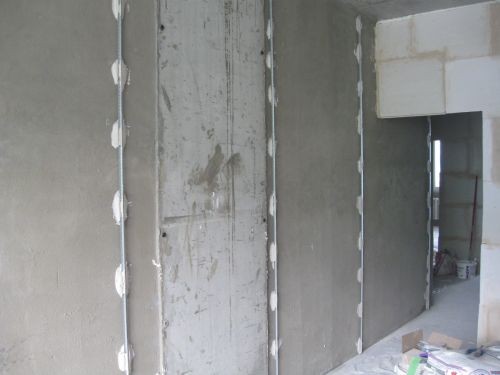
- First, install the side beacons at different ends of the wall, and then intermediate. The distance between the profiles should be slightly smaller than the length of the tool that you will apply the plaster. A couple of words about the tools: you will need a blade for applying and smoothing the solution, a drill-mixer, a capacity for kneading and a plastered falcon. Many work without plaster falcon, but meanwhile it greatly simplifies the process. This is a square shield with a pen of about 40x40 cm, which is applied to plaster so that each time they do not bent to a bucket.
- When everything is ready, you can apply plaster. Take a shoulder blade in one hand, a falcon in the other and pick up a little solution on it. Throw a small amount of the mixture onto the wall and proceed to leveling. To transfer the mixture from the falcon to the wall, attach it to the surface and direct it from the bottom-up.

- At first, it will be difficult to achieve a completely flat surface, but dexterity will come with practice. Lighthouses help to understand how to align the walls in the house, but for the guidelines you can take any rails of the required length up to 3 cm wide and the thickness of the plastering layer. First, flatter the solution between the beacons with a half, then install the rule on them and draw them from the bottom-up. Throw out the solution until the plaster is flush with the tops of the beacons.
- When the surface is flat, carefully remove the beacons from the wall, and fill the remaining grooves with a solution and align it with a spatula.
- Another difficulty is how to align the angle of the wall. At the junction with the ceiling or two adjacent walls, you need to create absolutely even corners. This can be done in terms of level or by bogram (on a plane) - it all depends on the nature of the finish. If you glue the wallpaper, smooth in level, if you plan to cover the walls with plaster or paint - by bogram.
- For internal corners, many use reinforcing tape. Apply the putty on the inside of the corner with a spatula moistened in the water. Moisten the reinforcing tape with water and bend in half along, put on the corner and slightly wind in the putty. Gently level it, straightening it from above-down. In the end, draw a damp spatula on both sides of the corner, holding its edge as close to the folding place as possible. Your task is to expel excess solution from under the tape. Apply the finish layer with an angular spatula. If there is a slight reef, correct this with a thin layer of finish putty.
Useful advice: When choosing a dry mixture, pay attention to the thickness of the layer, as well as the nature of the binding component. For example, it is recommended to take gypsum solutions for premises with low or normal degree of humidity, since in the kitchen or in the bathroom such walls are quickly damp and cracked. For wet rooms, choose a mineral -based mixture. You can cook cement plaster with your own hands by mixing 1 part of the brand cement at least 400 with 6 parts of sifted fine sand and diluting everything with water to a cream -like state. You can vary the amount of sand to get the different plasticity of the solution - the smaller the sand, the more plastic the solution, and it is easier to work with it (but the cement will need more, which means that the cost of repairs will increase). Attention! You need to use the finished solution in 1-2 hours, otherwise it will freeze or lose its properties, so do not immediately knead large volumes.
Squeezing with drywall
To align the walls with drywall is much easier than dry building mixtures. This work is much cleaner, faster and more suitable for novice builders. A wide range of GCL allows you to work in almost any room, even with a high level of humidity. In addition, drywall allows you to align the walls with strong differences in height and horizontal, on which it would be necessary to apply an too thick layer of plaster. And although this method is relevant for decoration with wallpaper or paint, in some cases it is the only way to get even and smooth walls.
There are two ways to install GKL for leveling walls: on the frame and on glue. The first method is suitable for surfaces with serious differences and helps to align wooden walls, the second can hide minor surface defects and get a perfectly even base for decoration. It is also permissible to combine these two options to achieve a neat docking of walls and ceiling. The frame method is most common, so we will consider it primarily and in all details.
For the manufacture of the frame, a special metal profile for GCL is used. Fixation is carried out through self -tapping screws and screws. Before telling the instructions on how to align the walls under wallpaper or tiles, you should mention one nuance of the frame method-due to the large thickness of the resulting skin, several centimeters of the useful area of \u200b\u200bthe walls on each side (about 4-5 cm) leaves. And if in a spacious room it can be imperceptible, then for small rooms it is better to use another method.
Instructions and videos, how to align the walls correctly:
- Remove the old coating from the walls and clean the surface.
- In this case, priming is necessary not to increase adhesion, but to strengthen and protect the walls from moisture and fungus. If you are shearing an external wall or wall in a wet room, treat it with an antiseptic.
- Build a frame from a galvanized profile, first mounting the UD profile on the floor, ceiling and neighboring walls to get the frame. Then, inside this framework, you can fix the jumpers from a thinner CD profile, which will hold the drywall sheets. In more detail, all the subtleties of the fastening process are described in the article " How to fix drywall to profile».
- When the frame is ready, you can proceed to the installation of GKL, but before that it is necessary to measure them, draw them and numbness so that they clearly fit into a given area. GKL is convenient in that it is easy to process at home by improvised tools. In the article " How to cut drywall sheets correctly»Everything is described in detail.
- To fill the seams between the sheets of drywall, use a special mickel grid. Stick it on the seams, and then cover the starting putty to take it to one level with the surface. Subsequent processing of the wall depends on the selected cladding. If you put a tile or other dense non -translucent material, you can simply smear the joints with putty and that’s it. But before painting or gluing the wallpaper, the wall should be completely covered with a white finish putty with a layer of 1-2 mm, sanded and primed. In the article " Wallpaper gluing on drywall»A lot of useful things are said on this subject.
But most often, the owners of the apartments do not want to sacrifice free space and build a frame. If the wall has local differences and defects in the form of mounds or recesses, they can be leveled with plaster or shut up to get a relatively smooth surface, and then paste it to the GCL. All technology is described in detail in articles " Leveling walls with drywall without a frame" And " Installation of drywall for glue. How to glue drywall correctly". You may also be useful to you article " How to install sockets in drywall».
Now you know how to level the walls under the tile, wallpaper or any other finish. We hope this article will help you quickly and efficiently make repairs with your own hands. Finally, we suggest that you familiarize yourself with another useful video on how to align the walls with drywall:
